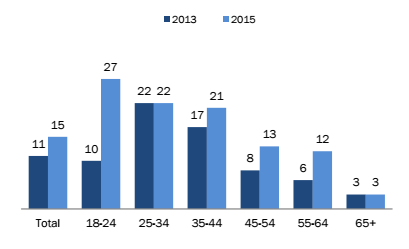College-Aged Adults Are Now the Most Likely Online Daters
It’s too simple to say that, once, college students met each other in person. College was scaffolded with social activities meant to introduce strangers to other strangers, whether it was speed dating or fraternity-sorority hang-outs.
But a new poll finds that an extraordinary technological change has taken place over the past three years.
Just two years ago, American adults ages 18 to 24 used online-dating sites and apps at an average rate for all American adults—about 10 percent. Since then, that rate has almost tripled. College-aged and post-college-aged Americans are now the most likely demographic to turn to the technology.
That’s the most interesting result from a Pew Research Center survey released Thursday on Americans’ online-dating habits. Conducted early last summer, the poll found that use of the services has grown modestly since 2013. Fifteen percent of Americans have now used a website or app to look for a romantic partner; three years ago, only nine percent had.
Recommended: Facebook and the New Colonialism
As it happens, the only group which has taken to online dating at a rate like very young adults have been older adults. Middle-aged Americans, 55 to 64, are now twice as likely to try looking for someone online since 2013. The technology also gained some users among 45-to-54-year-olds.
Percent in each age group which has ever used an online-dating website or mobile app

The survey also found that acceptance—or, at least, awareness—of online dating was growing. Eighty percent of Americans think a website like OkCupid or an app like Tinder are good ways to meet people. Healthy majorities also agree that online dating is easier, more efficient, and helps people find better matches. (Which makes me wonder how much the idea of some matches being algorithmically better than others has been sold by online-dating companies.)
Almost 30 percent of Americans know a long-term relationship which sprang from online dating; about 40 percent of them know someone who uses it.
Most interesting to me: These two numbers leap up significantly among affluent or college-educated Americans. Forty-six percent of college graduates know people who met their spouse or partner online. And 58 percent of college-educated Americans, and also Americans who make more than $75,000 per year, knew someone who used a dating site or app: These were the only two majorities recorded for this part of the section. (That said, college graduates don’t use dating services at more than an average rate.)
Recommended: The Research Pirates of the Dark Web
What made millennial adoption of online dating grow so much? The survey doesn’t say, but it provides some clues. In the two years between this Pew poll and the last, the percent of 18 to 24-year-olds who had used dating apps on their phone vaulted from five percent to 22 percent. Over the same period of time, use of Tinder, Hinge, and apps like them exploded. Just for reference, in February 2013, The New York Times first covered Tinder, “a new mobile dating application…with a difference”; by January 2016, it could refer to “Tinder dates” without further explanation.
Across all American adults, use of dating apps tripled, though the raw numbers aren’t as impressive. In 2013, three percent had used a smartphone dating app. By 2015, nine percent had.
The study polled 2,001 adults in the United States, mostly during June of last year. The survey included men and women, of many races and educational backgrounds, from all 50 states. The study’s author, Aaron Smith, said that answers across genders stayed surprisingly stable. In fact, there was only one place where responses differed among genders. More than half of the women surveyed said that online dating was a more dangerous way to meet people than other approaches. Only 38 percent of men said they felt the same way.
It’s like that old quote, often attributed to Margaret Atwood: Women are afraid men will kill them. Men are afraid women will swipe left on them.
Related Video
Read more from The Atlantic:
This article was originally published on The Atlantic.
